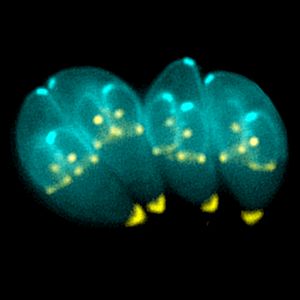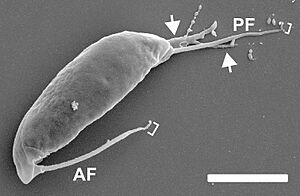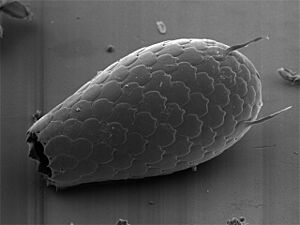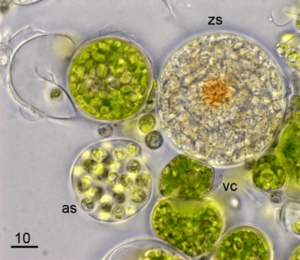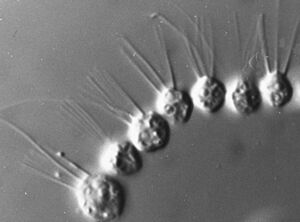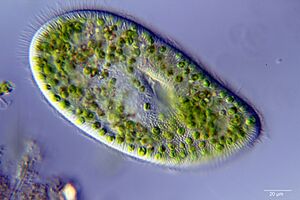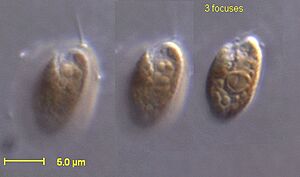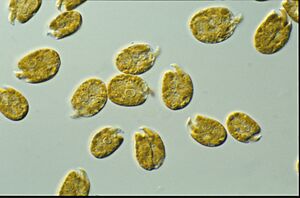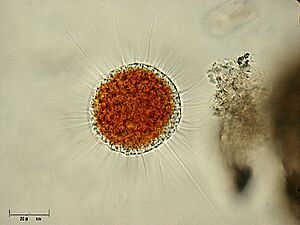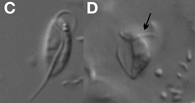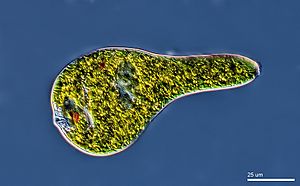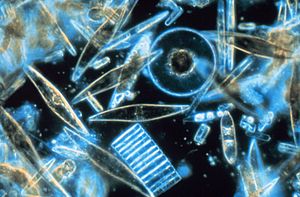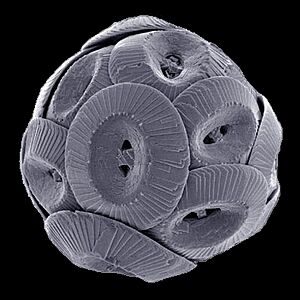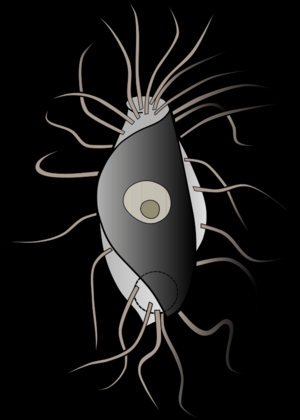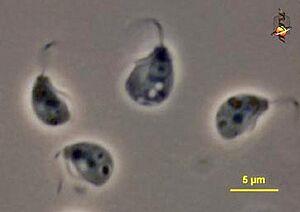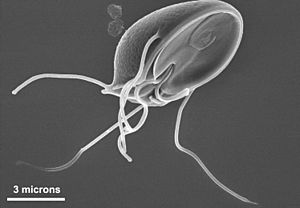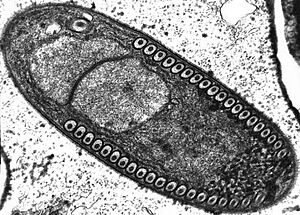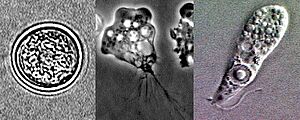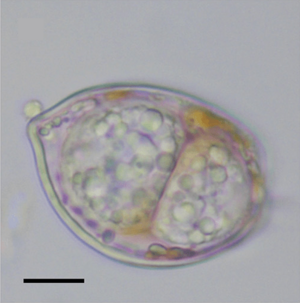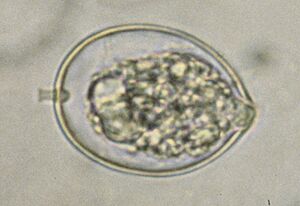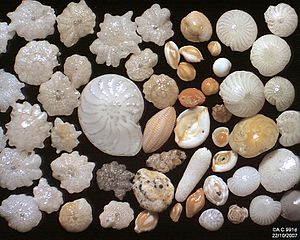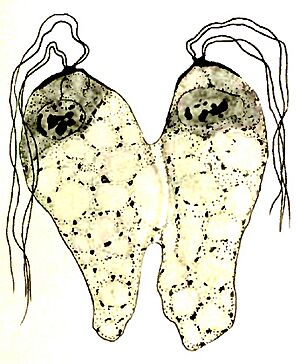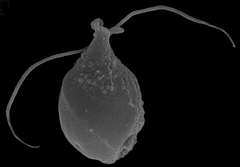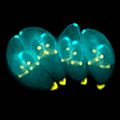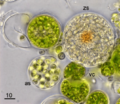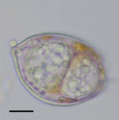Phylum facts for kids
In biology, a phylum is a major group used to classify living things. It's like a big folder where scientists put organisms that share a basic body plan or are closely related through evolution. A phylum is a step in the classification system, coming after kingdom and before class.
For example, the animal kingdom, Animalia, has about 31 phyla. The plant kingdom, Plantae, has about 14 phyla, and the fungus kingdom, Fungi, has around 8 phyla. Scientists are always learning more about how these groups are related, especially through studying their evolutionary history.
Contents
What is a Phylum?
The word "phylum" was created in 1866 by a scientist named Ernst Haeckel. It comes from a Greek word, phylon, which means "race" or "stock." Haeckel thought of a phylum as a group of all species that have slowly developed from one common original form. Think of it like a family tree where all the branches from a certain ancestor are part of the same phylum.
In simple terms, phyla are groups of organisms that have a similar general body design. For example, all animals in the Chordata phylum (like us!) have a backbone or a similar rod-like structure at some point in their lives.
One way to define a phylum is by how closely organisms are related through their evolutionary history. The main idea is that all organisms in a phylum should be more closely related to each other than to any other group.
However, this can be tricky! As scientists get more information, especially from studying DNA, they learn more about these relationships. This means phyla can sometimes be combined or split apart.
For instance, the "bearded worms" were once thought to be their own phylum. But later, DNA studies showed they were actually a type of annelid worm. So, they were moved into the Annelida phylum. On the other hand, a phylum called Mesozoa was split into two new phyla when scientists found out their members were not as closely related as once thought.
Because of these changes, some biologists think we should just group organisms into "clades" (groups with a common ancestor) without giving them formal ranks like "phylum."
Grouping by Body Plan
Another way to define a phylum is based on its "body plan." This idea was suggested by paleontologists (scientists who study fossils) Graham Budd and Sören Jensen. It's especially helpful for classifying extinct organisms, which are harder to study.
By this definition, a phylum is identified by a set of features that all its living members share. This approach makes it easier to classify fossils, as you can see which phylum they most resemble based on their body features. However, it relies on deciding which groups should be considered phyla, which can be a bit subjective.
Animal Phyla
The animal kingdom has many different phyla. The exact number can vary depending on how scientists count them, especially since some species haven't been discovered yet! For example, there are about 25,000 to 27,000 known types of nematodes (roundworms), but some guess there could be millions more.
Here are some of the main animal phyla:
| Phylum | Meaning | Common name | Key Features | Known Species |
|---|---|---|---|---|
| Acanthocephala | Thorn head | Thorny-headed worms | Worm with a spiky snout | 1,420 |
| Annelida | Little ring | Segmented worms | Many circular body segments | 22,000+ living |
| Agmata | Fragmented | Agmates | Cone-shaped shells made of calcium | 5 species, extinct |
| Archaeocyatha | Ancient cups | Archaeocyathids | Extinct sponge-like reef builders from the Early Cambrian period | 3 known classes (Extinct) |
| Arthropoda | Jointed foot | Arthropods | Segmented bodies, jointed legs, hard outer shell (exoskeleton) | 1,250,000+ living; 20,000+ extinct |
| Brachiopoda | Arm foot | Lampshells | Special feeding organ (lophophore) and a stalk (pedicle) | 300–500 living; 12,000+ extinct |
| Bryozoa (Ectoprocta) | Moss animals | Moss animals, sea mats | Lophophore, no pedicle, tiny hair-like tentacles | 6,000 living |
| Chaetognatha | Longhair jaw | Arrow worms | Spines on head, fins | About 100 living |
| Chordata | With a cord | Chordates | Hollow nerve cord, notochord (rod-like support), gill slits, tail | About 55,000+ |
| Cnidaria | Stinging nettle | Cnidarians | Stinging cells (nematocysts) | About 16,000 |
| Ctenophora | Comb bearer | Comb jellies | Eight "comb rows" of fused cilia | About 100–150 living |
| Cycliophora | Wheel carrying | Symbion | Circular mouth with tiny hairs, sac-like body | 3+ |
| Echinodermata | Spiny skin | Echinoderms | Five-part radial symmetry, spiny skin | About 7,500 living; about 13,000 extinct |
| Entoprocta | Goblet worms | About 150 | ||
| Gastrotricha | Hairy stomach | Gastrotrich worms | Two sticky tubes at the end of the body | About 690 |
| Gnathostomulida | Jaw orifice | Jaw worms | Tiny worms with no body cavity, related to rotifers | About 100 |
| Hemichordata | Half cord | Acorn worms | Stomochord (rod-like structure) in collar, gill slits | About 130 living |
| Kinorhyncha | Motion snout | Mud dragons | Eleven body segments, each with a top plate | About 150 |
| Loricifera | Armour bearer | Brush heads | Umbrella-like scales at each end | About 122 |
| Micrognathozoa | Tiny jaw animals | None | Body can stretch like an accordion | 1 |
| Mollusca | Soft | Mollusks / molluscs | Muscular foot, mantle (tissue that forms a shell) | 85,000+ living; 80,000+ extinct |
| Monoblastozoa | None | Distinct front and back, covered in tiny hairs | 1 | |
| Nematoda | Thread like | Round worms, thread worms | Round body shape, tough outer layer (cuticle) | 25,000 |
| Nematomorpha | Thread form | Horsehair worms, Gordian worms | Long, thin parasitic worms, similar to nematodes | About 320 |
| Nemertea | A sea nymph | Ribbon worms | Unsegmented worms with a proboscis (tube-like organ) | About 1,200 |
| Onychophora | Claw bearer | Velvet worms | Worm-like body with legs ending in claws | About 200 living |
| Orthonectida | Orthonectid | Tiny, simple, parasitic worms | 20 | |
| Petalonamae | Shaped like leaves | None | Extinct, leaf-shaped, bottom-dwelling organisms from the Ediacaran period | 3 classes, extinct |
| Phoronida | Zeus's mistress | Horseshoe worms | U-shaped gut | 11 |
| Placozoa | Plate animals | Trichoplaxes | Flat body with distinct top and bottom, two layers of ciliated cells | 4+ |
| Platyhelminthes | Flat worm | Flatworms | Flattened body, no body cavity. Many are parasites. | About 29,500 |
| Porifera | Pore bearer | Sponges | Body full of holes, simplest animals | 10,800 living |
| Priapulida | Little Priapus | Worms | About 20 | |
| Proarticulata | Before articulates | Proarticulates | Extinct, mattress-like organisms with "glide symmetry" from the Ediacaran period | 3 classes, extinct |
| Rhombozoa (Dicyemida) | Lozenge animal | Rhombozoans | Single-celled parasites with a central axis, surrounded by ciliated cells | 100+ |
| Rotifera | Wheel bearer | Rotifers | Crown of cilia (tiny hairs) at the front | About 2,000 |
| Saccorhytida | Pocket and wrinkle | None | Tiny (1mm) spherical body with a large mouth, thick but flexible skin, 8 openings around the body. Extinct. | 2 species, extinct |
| Tardigrada | Slow step | Water bears, moss piglets | Microscopic, four-segmented body and head, relatives of arthropods | 1,000 |
| Trilobozoa | Three-lobed animal | Trilobozoan | Extinct, mostly disc-shaped organisms with three-part symmetry from the Ediacaran period | 18 genera, extinct |
| Vetulicolia | Ancient dweller | Vetulicolian | Two-part body: large front with a mouth and gill-like openings, segmented back part. Extinct. | 15 species, extinct |
| Xenacoelomorpha | Strange hollow form | Subphylum Acoelomorpha and xenoturbellida | Small, simple animals lacking typical bilateral structures like gut cavities | 400+ |
Plant Phyla
The plant kingdom also has different ways of being defined. All definitions include land plants (embryophytes). Some also include green algae. The table below shows a common way plants are grouped into divisions (which are like phyla for plants).
The way plants are classified can change as scientists learn more. For example, some sources put horsetails and ferns in different divisions, while others put them together.
| Division | Meaning | Common name | Key Features | Known Species |
|---|---|---|---|---|
| Anthocerotophyta | Anthoceros-like plants | Hornworts | Horn-shaped spore-producing parts, no water-carrying system | 100-300+ |
| Bryophyta | Bryum-like plants | Mosses | Spore-producing parts that stay attached, no water-carrying system | About 12,000 |
| Charophyta | Chara-like plants | Charophytes | About 1,000 | |
| Chlorophyta | Green plants | Chlorophytes | About 7,000 | |
| Cycadophyta | Cycas-like plants | Cycads | Seeds, crown of large leaves | About 100-200 |
| Ginkgophyta | Ginkgo-like plants | Ginkgo, maidenhair tree | Seeds not inside a fruit (only one living species) | Only 1 living; 50+ extinct |
| Glaucophyta | Blue-green plants | Glaucophytes | 15 | |
| Gnetophyta | Gnetum-like plants | Gnetophytes | Seeds and woody water-carrying system with vessels | About 70 |
| Lycopodiophyta, |
Lycopodium-like plants Wolf plants |
Clubmosses & spikemosses | Small leaves, water-carrying system | 1,290 living |
| Magnoliophyta | Magnolia-like plants | Flowering plants, angiosperms | Flowers and fruit, water-carrying system with vessels | 300,000 |
| Marchantiophyta, Hepatophyta |
Marchantia-like plants Liver plants |
Liverworts | Spore-producing parts that don't last long, no water-carrying system | About 9,000 |
| Polypodiophyta, | Polypodium-like plants |
Ferns | Large leaves, water-carrying system | About 10,560 |
| Picozoa | Extremely small animals | Picozoans, picobiliphytes, biliphytes | 1 | |
| Pinophyta, Coniferophyta |
Pinus-like plants Cone-bearing plant |
Conifers | Cones with seeds, wood made of tracheids | 629 living |
| Prasinodermophyta | Prasinoderma-like plants | Picozoans, picobiliphytes, biliphytes | 8 | |
| Rhodophyta | Rose plants | Red algae | Use special pigments for color | About 7,000 |
Fungi Phyla
The kingdom Fungi includes many different types of organisms, from mushrooms to molds. Here are some of their main divisions (phyla):
| Division | Meaning | Common name | Key Features | Known Species |
|---|---|---|---|---|
| Ascomycota | Bladder fungus | Ascomycetes, sac fungi | Often have cup-shaped fruiting bodies. Can reproduce without a partner. | 30,000 |
| Basidiomycota | Small base fungus | Basidiomycetes, club fungi | Includes bracket fungi, toadstools, smuts, and rusts. Reproduce with a partner. | 31,515 |
| Blastocladiomycota | Offshoot branch fungus | Blastoclads | Less than 200 | |
| Chytridiomycota | Little cooking pot fungus | Chytrids | Mostly live in water, either feeding on dead matter or as parasites. Have a whip-like tail. | 1,000+ |
| Glomeromycota | Ball of yarn fungus | Glomeromycetes, AM fungi | Mostly form special connections with plant roots. Reproduce without a partner but need plant roots. | 284 |
| Microsporidia | Small seeds | Microsporans | 1,400 | |
| Neocallimastigomycota | New beautiful whip fungus | Neocallimastigomycetes | Mostly found in the guts of plant-eating animals. | About 20 |
| Zygomycota | Pair fungus | Zygomycetes | Most feed on dead matter and can reproduce both with and without a partner. | About 1,060 |
The phylum Microsporidia is usually part of Fungi, but its exact place is still being studied. Also, scientists are thinking about splitting the Zygomycota phylum into several new groups because its members aren't as closely related as once thought.
Protista Phyla
The kingdom Protista is a very diverse group. It includes all eukaryotes (organisms with complex cells) that are not plants, animals, or fungi. Because it's such a mixed group, scientists are still working on the best way to classify them. Many of the phyla listed below are used by different scientific groups.
| Phylum | Meaning | Common name | Key Features | Known Species | Image |
|---|---|---|---|---|---|
| Amoebozoa | Amorphous animals | Amoebozoans | Move using "false feet" (pseudopodia) | About 2,400 | |
| Apicomplexa | Apical infolds | Apicomplexans, sporozoans | Mostly parasites, have a special structure to invade host cells | Over 6,000 | |
| Apusozoa | Apusomonas-like animals | Glide using two or three whip-like tails (flagella) | 32 | ||
| Bigyra | Two rings | Have a double helix in their whip-like tail's connection zone | |||
| Cercozoa | Flagellated animal | Cercozoans | Identified by DNA, don't have very clear physical features | ||
| Chromerida | Chromera-like organisms | Chrompodellids, chromerids | Two whip-like tails, chloroplasts with four membranes | 8 | |
| Choanozoa | Funnel animals | Opisthokont protists | Have thread-like false feet; some have a collar of tiny hairs around a whip-like tail | About 300 | |
| Ciliophora | Cilia bearers | Ciliates | Have many tiny hairs (cilia) and a "mouth" | About 4,500 | |
| Cryptista | Hidden | Identified by DNA, have flat structures inside their cells | 246 | ||
| Dinoflagellata | Whirling flagellates | Dinoflagellates | Two whip-like tails, one wraps around the cell, the other points backward | 2,957 living; 955 fossil | |
| Endomyxa | Within mucus | Identified by DNA, often parasites inside other eukaryotes | |||
| Eolouka | Early groove | Two whip-like tails, with a groove on their underside for feeding | 23 | ||
| Euglenozoa | True eye animals | Two whip-like tails, one in a special pocket, unique tail structure | 2,037 living; 20 fossil | ||
| Ochrophyta, |
Ochre plants | Heterokont algae | Two whip-like tails, chloroplasts with four membranes and chlorophyll a and c | 21,052 living; 2,262 fossil | |
| Haptista | Fasten | Thin, microtubule-based feeding arms, complex mineral scales | 517 living; 1,205 fossil | ||
| Hemimastigophora | Atypical flagellates | Hemimastigotes | Oval or worm-like, two rows of cilia, plates under the membrane | 10 | |
| Malawimonada | Malawimonas-like organisms | Malawimonads | Small, free-living, two whip-like tails, one or two vanes on the back tail | 3 | |
| Metamonada | Middle monads | Metamonads | Live without oxygen, some have no mitochondria; four whip-like tails per unit | ||
| Opisthosporidia | Spores with a tail | Parasites with tough spores and a way to invade host cells | |||
| Percolozoa | Percolomonas-like animals | Complex life cycle with amoebae, flagellates, and cysts | |||
| Perkinsozoa | Perkinsus-like animals | Perkinsozoans | Parasitic, two whip-like tails, can form spore-like structures | 26 | |
| Provora | Devouring protists | Identified by DNA, free-living, eat other eukaryotes, two whip-like tails | 7 | ||
| Pseudofungi | False fungi | Identified by DNA, eat by engulfing food, have a spiral structure in their whip-like tail's connection zone | Over 1,200 | ||
| Retaria | Organisms with net-like feet | Feed using net-like or rod-like false feet, often through a skeleton | 10,000 living; 50,000 fossil | ||
| Sulcozoa | Groove-bearing animals | Live with oxygen, have 0, 1, 2, or 4 whip-like tails, a stiff outer layer, and a feeding groove | 40+ | ||
| Telonemia | Telonema-like organisms | Telonemids | Eat by engulfing food, pear-shaped, two whip-like tails, unique internal structure | 7 |
Bacteria Phyla
Bacteria are tiny, single-celled organisms. There are currently 40 recognized bacterial phyla. Here are a few examples:
- Acidobacteriota: A diverse group, many of which haven't been grown in labs yet.
- Actinomycetota: Includes bacteria with high G+C content in their DNA, like some that cause diseases.
- Bacillota: Includes bacteria with low G+C content, like Bacilli (which can form spores) and Clostridia.
- Chlamydiota: Often live inside other cells as parasites.
- Chlorobiota: Green sulfur bacteria, which use light for energy.
- Pseudomonadota: A very well-known phylum, including common bacteria like Escherichia coli (E. coli) and Pseudomonas aeruginosa.
- Spirochaetota: Includes bacteria like Borrelia burgdorferi, which causes Lyme disease.
Archaea Phyla
Archaea are also single-celled organisms, similar to bacteria but with different evolutionary histories. Currently, two phyla are officially recognized:
- Nitrososphaerota
- Thermoproteota: The second most common archaeal phylum.
Other phyla have been suggested but are not yet officially named, such as "Euryarchaeota" (the most common archaeal phylum) and "Nanoarchaeota" (tiny organisms that live with other organisms).
Images for kids
See also
 In Spanish: Filo para niños
In Spanish: Filo para niños



